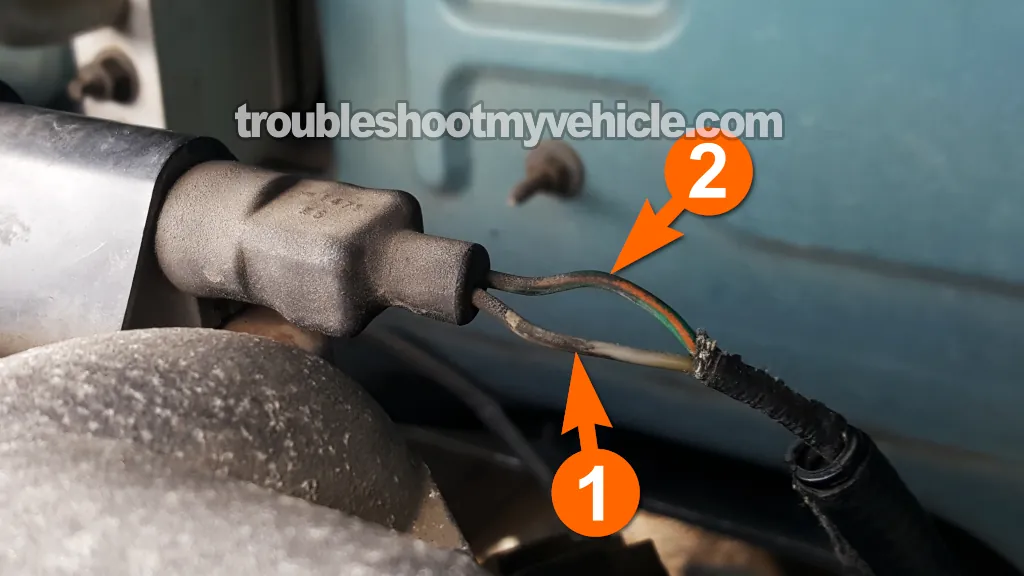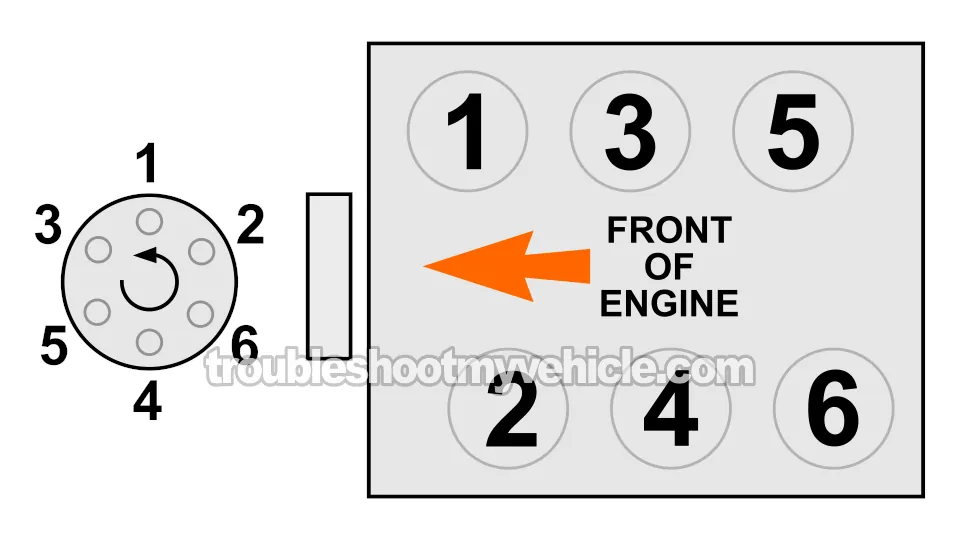
This tutorial will help diagnose an issue with the ignition system that is causing a cylinder misfire problem or an engine no-start problem.
All of the test steps are explained in a step-by-step manner and in plain English. With your test results, you'll quickly find out if an ignition system component is causing a cylinder misfire issue or an engine no-start problem.
Contents of this tutorial:
- Symptoms Of Ignition System Problems.
- Ignition Coil Connector Circuit Descriptions.
- What Tools Do I Need?
- TEST 1: Checking All Six Spark Plug Wires For Spark.
- TEST 2: Checking For Spark Directly On The Distributor Cap.
- TEST 3: Checking The Ignition Coil High Tension Wire For Spark.
- TEST 4: Checking For Spark Directly On The Ignition Coil Tower.
- TEST 5: Making Sure The Ignition Coil Is Getting 12 Volts.
- TEST 6: Checking The Ignition Coil's Activation Signal.
- Other Possible Misfire Causes.
APPLIES TO: This tutorial applies to the following vehicles:
- 3.0L Dodge Caravan: 1996, 1997, 1998, 1999, 2000.
- 3.0L Dodge Grand Caravan: 1996, 1997, 1988, 1999, 2000.
- 3.0L Plymouth Voyager: 1996, 1997, 1998, 1999, 2000.
- 3.0L Plymouth Grand Voyager: 1996, 1997, 1998, 1999, 2000.
WIRING DIAGRAMS:
- Ignition System Wiring Diagram (1996-1997 3.0L V6 Dodge And Plymouth Minivan).
- Ignition System Wiring Diagram (1998-1999 3.0L V6 Dodge And Plymouth Minivan).
- Ignition System Wiring Diagram (2000 3.0L V6 Dodge And Plymouth Minivan).
IGNITION SYSTEM TESTS:
- How To Test The Cam Sensor (1996-2000 3.0L Caravan, Grand Caravan, Voyager, Grand Voyager).
- How To Test The CKP Sensor (1996-1997 3.0L Caravan, Grand Caravan, Voyager, Grand Voyager).
- How To Test The Crankshaft Position Sensor (1998-2000 3.0L Caravan, Grand Caravan, Voyager, Grand Voyager).
ENGINE NO-START DIAGNOSTICS:
1988-1995 IGNITION SYSTEM TESTS:
- Ignition Distributor System Tests (1988-1995 3.0L Chrysler, Dodge, Plymouth) (at: easyautodiagnostics.com)
Symptoms Of Ignition System Problems
In a nutshell, ignition system problems will come in one of two flavors: either the engine is not going to start or the engine is going to misfire.
The following is a list of the most common symptoms you'll see when the ignition system is causing an engine performance problem:
- Cylinder misfire: This can cause the engine to run rough at idle and you'll definitely feel the misfire when you accelerate.
- Check engine light on: On OBD II equipped vehicles, the check engine light will illuminate when the ignition system is causing a cylinder misfire problem.
- Misfire trouble codes: You'll see one or more of the following cylinder misfire trouble codes:
- P0300: Random Cylinder Misfire.
- P0301: Cylinder #1 Misfire.
- P0302: Cylinder #2 Misfire.
- P0303: Cylinder #3 Misfire.
- P0304: Cylinder #4 Misfire.
- P0305: Cylinder #5 Misfire.
- P0306: Cylinder #6 Misfire.
- Rough idle: The engine may vibrate or shake excessively at idle.
- Reduced power: The engine may not produce as much power as it normally does.
- Bad gas mileage: The vehicle may get worse gas mileage than usual.
- Engine doesn't start: This is the worst case scenario and happens when the ignition coil stops creating and supplying spark to all six cylinders.
Ignition Coil Connector Circuit Descriptions

| 1996-1998 | ||
|---|---|---|
| Wire | Color | Description |
| 1 | Grey (GRY) | Ignition Coil Control Signal |
| 2 | Dark green with orange stripe (DK GRN/ORG) | Sensor Ground |
| 1999-2000 | ||
|---|---|---|
| Wire | Color | Description |
| 1 | Grey with red stripe (GRY/RED) | Ignition Coil Control Signal |
| 2 | Dark green with orange stripe (DK GRN/ORG) | Sensor Ground |
What Tools Do I Need?
To troubleshoot the ignition system, you'll need a few basic tools. Here's the list:
- A spark tester.
- You can use any spark tester, the one that I use and always recommend (for its ease of use and accuracy) is the HEI spark tester (by OTC).
- You can see an example of the HEI spark tester and where to buy it here: The HEI Spark Tester (The Best Spark Tester On the Market) (at: easyautodiagnostics.com).
- A multimeter.
- An LED light.
- You can see an example of this tool here and where to buy it: The LED Light Test Tool And How To Make One (at: easyautodiagnostics.com).
- Battery jump start cables.
- Someone to help you crank the car.
TEST 1: Checking All Six Spark Plug Wires For Spark
To get the most accurate test result from your ignition system diagnostic, I recommend that you test all six spark plug wires for spark.
The accomplish this test without any complications, I'm going to make two recommendations:
- Use a spark plug wire puller to disconnect the spark plug wires from the spark plugs.
- Use a spark tester for the spark test. You can use any type of spark tester. The one I use and always recommend is the OTC HEI Spark Tester.
It's a common issue for the spark plug wire's metal terminal to stay stuck on the spark plug when you're trying to remove them (without a spark plug wire puller). This usually happens due to the terminal gripping the spark plug too tightly (which is normal).
Using a spark plug wire puller can help you avoid this problem. They're designed to provide a better grip and leverage on the spark plug wire, which allows you to apply even pressure on the wire when pulling it off of the spark plug.
More importantly, you'll be able to safely remove all of the spark plug wires without damaging them or risking their metal terminals staying stuck on the spark plugs.
If you don't have a spark tester and need to buy one, you can see an example of the OTC HEI spark tester and where to buy it here: The HEI Spark Tester (The Best Spark Tester On the Market) (at: easyautodiagnostics.com)
CAUTION: The spark test involves cranking the engine! Be careful and take all necessary precautions when working around a cranking engine.
Let's get started:
- 1
Remove the spark plug wire (high tension cable) from the cylinder #1 spark plug.
- 2
Attach the spark tester to the spark plug wire.
- 3
Connect the spark tester to the battery negative (-) post with a battery jump start cable.
You can also connect the spark tester to a clean and unpainted metal surface on the engine. - 4
Have your helper crank the vehicle while you keep you eye on the spark tester.
CAUTION: The engine may or may not start, either way be careful. - 5
You're gonna get one of two results: Spark or no spark.
- 6
Reconnect the spark plug wire to the spark plug.
- 7
Repeat this test on the other spark plug wires.
Let's take a look at what your test results mean:
CASE 1: You got spark from all six spark plug wires. This is the correct test result. You can conclude that all of the components of the ignition system are OK.
To be a bit more specific, you can conclude that the spark plug wires, distributor cap and rotor, crankshaft position sensor, and ignition coil are working.
If you mini-van is misfiring, check out this section: Other Possible Misfire Causes to see further tips and suggestions.
CASE 2: All six spark plug wires DID NOT spark. The next step is to check that the distributor cap is receiving spark. For this test go to: TEST 3: Checking The Ignition Coil High Tension Wire For Spark.
CASE 3: You got spark on most but not all of the spark plug wires. This usually indicates that the spark plug wire (that did not spark) or the distributor cap is bad.
Your next step is to check for spark directly on the distributor cap towers of the wires that did not spark. For this test go to: TEST 2: Checking For Spark Directly On The Distributor Cap.


